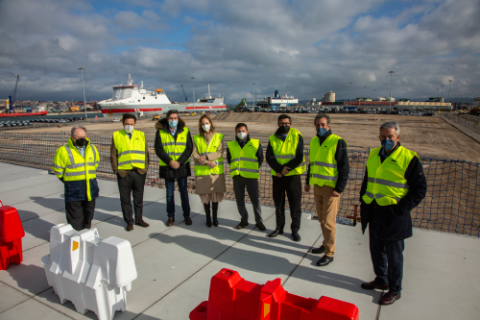
The president of Puertos del Estado and the Port Authority of Santander verify the change in the physiognomy of the port of Santander thanks to the "high number" of ongoing investments
The maximum authority of the Port Authority of Santander accompanied Rodríguez Dapena this morning, in his first official visit as president of Puertos del Estado, to the Cantabrian dock.
In addition to verifying the progress of the works on-site, meetings were held to address other issues such as Brexit, railway accessibility, intrusion, the relocation of the headquarters, or the port-city interaction.
Santander, January 28, 2022. The president of the Port Authority of Santander, Francisco Martín, toured the port facilities this morning to introduce his counterpart at Puertos del Estado to what he called "the new port of Santander."
During Rodríguez Dapena's first official visit to the port infrastructure as president of Puertos del Estado, who, according to Martín, "knows the port almost even better than I do," they reviewed the main advances being made in terms of infrastructure. According to the Cantabrian leader, these advances represent "a change in the physiognomy, operability, and overall conception of the port." For the president of the Port Authority, "this transformation is the result of the port's model change, with its commitment to general cargo and energy sustainability," a "high added value" shift fundamental for the industry in Cantabria, allowing it to break historical cargo records.
The president of Puertos del Estado thanked the president of the Cantabrian port for his reception and congratulated him on his management commitment to traffic efficiency and sustainability, stating, "At Puertos del Estado, we are working to make ports more sustainable, innovative, and secure, and therefore, more competitive, and the port of Santander is a clear example of this."
Thus, Martín showed the president of Puertos del Estado a "work in progress" port that must coexist with "excellence in day-to-day operations." With over 180 million euros in public-private investments, the highest authority of the Cantabrian dock accompanied him to visit the infrastructures "that will rationalize the port space without resorting to bay fillings or the construction of a super-port." After visiting the construction of the Maliaño 1-4 docks and what will be its ro-ro ramp and liquefied natural gas supply station, the Raos 6 and Raos 9 docks, the car silo, the fertilizer and container terminals, or the renewal of the double railway track to access the port, both presidents, along with their teams, met to discuss other relevant issues such as Brexit, intrusion, port-city interaction, or railway accessibility.
Regarding the latter point, the president of the Port Authority emphasized the need to "decisively" support rail freight transport "if we want to reduce emissions and work towards sustainable mobility" and highlighted the importance of Santander being connected to the Basque Y.
In turn, Rodríguez Dapena defended "the country's need to increase its share of rail freight transport" and emphasized that "the Spanish port system contemplates an investment of one billion euros to improve its integration with the railway."
They also studied the impact that Brexit has had on the port's operation and discussed the threat posed by intrusion cases in day-to-day activities. Regarding the port-city relationship, Martín informed the president of Puertos del Estado about the creation of a master plan, prepared by the consulting firm ARUP, which will soon be presented and contains a new vision and organization of the uses of port lands that will allow, in turn, a significant reorganization of the waterfront.
Representatives from Puertos del Estado also had the opportunity to meet with the main consignees, concessionaires, and service providers of the port to hear firsthand their contributions to achieving better port operation.

